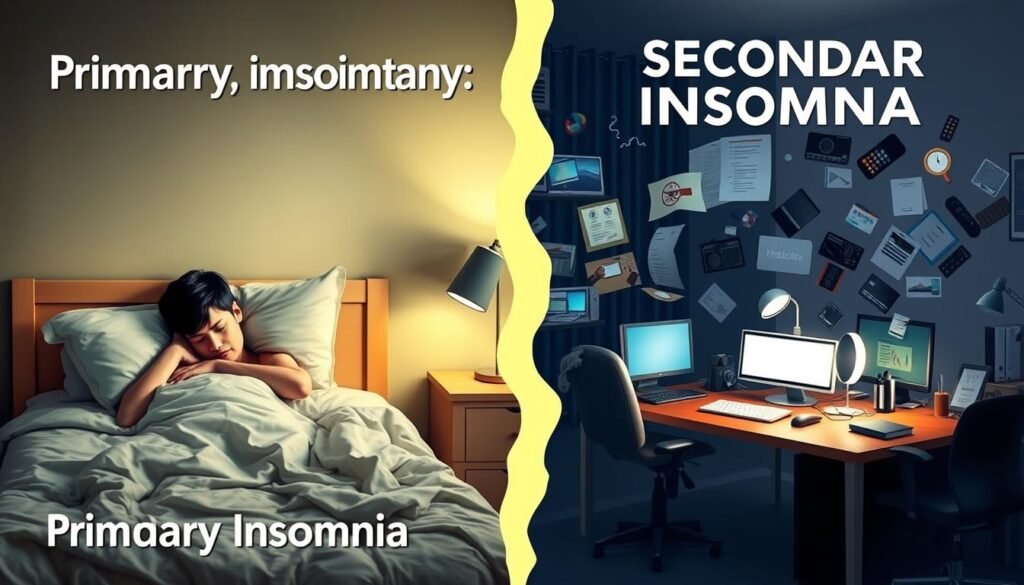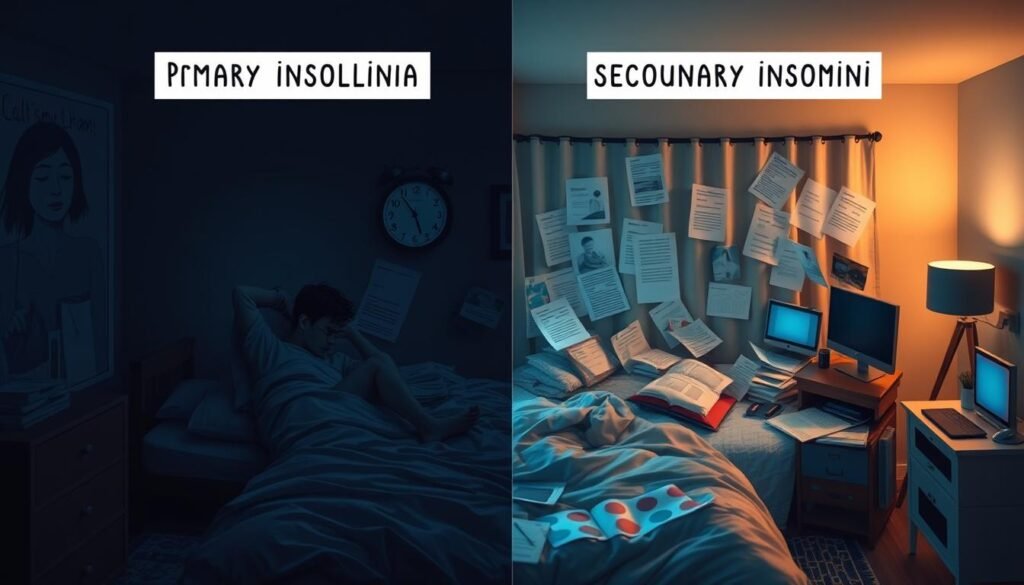Did you know around 30% of U.S. adults have insomnia symptoms, with 10% seriously affected in their daily life? This fact shows how common and serious sleep disorders can be. Insomnia is split into primary and secondary types. Recognizing their differences is key for the right treatment. Primary insomnia happens on its own, while secondary comes from other health issues like anxiety or chronic pain. Knowing this helps people manage their sleep better and boost their overall well-being.
Key Takeaways
- Approximately 30% of adults in the U.S. experience insomnia symptoms annually.
- Primary insomnia is independent of other health conditions, while secondary insomnia is linked to underlying issues.
- Effective treatment for insomnia can improve both sleep quality and mental health.
- Choosing the right antidepressant, as discussed in this treatment guide, can significantly affect sleep quality.
- Understanding the differences helps tailor approaches to enhance sleep hygiene and well-being.
What is Insomnia?
Insomnia is a common sleep disorder. It makes starting or keeping sleep hard, often resulting in not enough rest. Knowing what insomnia means helps in finding its causes and treatments. People with insomnia may find it hard to fall asleep. They might wake up often at night. They could also wake up too early and not feel rested.
Definition and Symptoms
Insomnia includes different sleep problems. Its symptoms impact both night and day, causing issues like fatigue and irritability. Common symptoms are:
- Daytime sleepiness
- Fatigue
- Difficulty concentrating
- Memory problems
- Grumpiness
Stress and lifestyle choices, like working late, can make these symptoms worse.
Types of Insomnia: Acute and Chronic
There are two main types of insomnia: acute and chronic. Acute insomnia is short-term, often due to stress. It lasts from one night to a few weeks. Chronic insomnia, on the other hand, happens at least three nights a week for three months or more. It might have no clear cause or be linked to health issues or using certain substances.
For more on insomnia, see the American Academy of Sleep Medicine’s fact sheet. It provides deep insights into this sleep disorder.
Primary vs. Secondary Insomnia
It’s crucial to know the difference between primary and secondary insomnia for effective sleep disorder treatments. Primary insomnia means you have ongoing sleep problems not caused by other health issues. On the other hand, secondary insomnia is sleep trouble due to conditions like depression or chronic pain. Knowing which type you’re dealing with is key to finding the right treatment plan.
Differences Between Primary and Secondary Insomnia
Primary insomnia shows up without a clear reason, not linked to stress or health problems. It affects about 10% of people, leading to a lot of sleep issues. These issues include not being able to fall asleep, stay asleep, or waking up too early. Secondary insomnia comes from other health problems. For example, anxiety or depression can lead to trouble sleeping because of those mental health struggles.
Examples of Each Type
Here are some examples to understand both kinds of insomnia. Someone with primary insomnia can’t sleep well without any obvious emotional or physical reasons. This can make them feel very tired and less productive. Meanwhile, a person with depression may face secondary insomnia, where their sleep problems are a sign of their mental state. Knowing the difference helps doctors create the right treatment plan to improve sleep.

Identifying whether insomnia is primary or secondary is crucial for managing it well. If you’re having trouble sleeping, see a doctor for a full approach to treatment. They take into account all possible reasons for your sleep issues. Also, looking into resources like physical signs of anxiety disorders can shed light on related symptoms and conditions.
Causes of Insomnia
To understand what causes insomnia, we look at primary and secondary reasons. Primary reasons often come from how we live or our natural tendencies. Secondary reasons are usually because of health problems. Knowing the difference helps us manage it better.
Primary Causes of Insomnia
Primary reasons for insomnia include how we live and our surroundings. Issues often seen are:
- Stress from life or work can mess with our sleep.
- Things like noise and light can stop us from sleeping well.
- Our genes, which play a role in how we handle sleep issues.
- Bad sleep habits, such as not having a regular bedtime or looking at screens too much.
Secondary Causes of Insomnia
Secondary causes of insomnia are linked to our health. Major factors include:
- Anxiety and depression, they make it hard to sleep well.
- Health issues like chronic pain or sleep problems such as sleep apnea.
- Some medicines can mess up our sleep.
- Using stuff like caffeine, nicotine, and alcohol affects how we sleep.

Types of Insomnia
Learning about the different types of insomnia helps us understand sleep problems better. Each kind affects how long you’re affected, what causes it, and why it happens. Here are the main types of insomnia people deal with.
Adjustment Insomnia
Adjustment insomnia appears when big life changes or stress happen. It can last a few days to weeks. Every year, 15% to 20% of people, especially older ones, face it due to their higher sensitivity to changes. Signs include trouble getting to sleep or waking up a lot at night.
Idiopathic Insomnia
Idiopathic insomnia is complex and starts in childhood, lasting a lifetime. Its causes aren’t clear, making it hard to figure out and manage. People with this type face ongoing sleep problems that frustrate them and lower their life quality.
Insomnia Related to Medical Conditions
Insomnia also happens with different health issues. Problems like chronic pain, cancer, and mental disorders can lead to sleep troubles. This kind requires treating the health problems behind it. Plus, things like alcohol and caffeine can make sleep worse, causing secondary insomnia along with other health problems.

Symptoms and Effects of Insomnia
Insomnia can greatly change how a person lives their day. It’s key to know its symptoms and effects. Doing so helps us understand what those with the disorder go through.
Common Symptoms Experienced by Insomniacs
Those with insomnia often face many symptoms. These issues hurt their well-being. Symptoms include:
- Inability to fall asleep or stay asleep
- Frequent awakenings during the night
- Fatigue upon waking
- Irritability and mood changes
- Difficulty concentrating throughout the day
Lack of sleep can make these problems worse. This leads to less sleep. Insomniacs might not realize how much they actually sleep. This can worry them more about their rest.
Daytime Effects of Insomnia
Insomnia affects not just the night, but the day too. It leads to many daytime problems. Some effects are:
- Increased fatigue and sleepiness, affecting productivity
- Heightened anxiety levels and potential mood disorders
- Impaired cognitive function, leading to concentration issues
- Risks for physical health problems such as obesity and high blood pressure
It’s crucial to handle insomnia well to lessen these effects. Changes in lifestyle, behavior, and getting mental health care help. For more on treatments, please see this resource.
Risk Factors for Insomnia
Knowing what increases the risk of insomnia can help us understand and prevent it. Demographic and lifestyle factors are key in causing sleep problems. It’s crucial to look into these to find preventive measures.
Demographic Risk Factors
Some people have a higher chance of facing insomnia due to their background. For example, studies show women are more likely to have it than men. Older adults, especially those over 60, often struggle with sleep. Also, if your family has a history of insomnia, you might be more prone to it.
Behavioral and Lifestyle Factors
Lifestyle choices can greatly affect your sleep. Drinking too much caffeine can mess up your sleep cycle. Bad sleep routines and high stress can also make sleep worse. Moreover, not exercising enough and napping too much during the day can spoil your night’s sleep.
| Risk Factor | Description |
|---|---|
| Gender | Females are twice as likely to suffer from insomnia compared to males. |
| Age | Older adults experience higher rates of insomnia, particularly those over 60. |
| Caffeine Consumption | Excessive caffeine intake can lead to sleep disruptions. |
| Physical Activity | Lack of exercise can contribute just to various sleep problems. |
| Stress | High stress levels from work or personal life are linked to insomnia. |
| Medical Conditions | Conditions like sleep apnea, arthritis, and diabetes significantly raise insomnia risk. |
Treatment Options for Insomnia
Looking for good treatments for insomnia can greatly improve life quality. Different methods are available, each addressing various sleep problems.
Cognitive Behavioral Therapy for Insomnia
Cognitive behavioral therapy (CBT) is often the first treatment suggested for insomnia. It aims to change the thoughts and actions that affect sleep badly. CBT deals with issues like anxiety and bad sleep habits to help achieve better sleep.
Role of Sleep Medications
Sometimes, CBT might not be enough on its own. Sleep medications, such as eszopiclone and zolpidem, can offer temporary help. However, these should be used with care to prevent unwanted effects and dependency. Patient education on proper medication usage is key to reducing risks.
Importance of Sleep Hygiene
Practicing good sleep hygiene is crucial for handling insomnia. Keeping a regular sleep routine, avoiding screens before bed, and making sure your sleeping area is cozy can drastically improve sleep. Combining these practices with other treatments offers a well-rounded approach to managing insomnia.
Chronic vs. Transient Insomnia
There are different types of insomnia, such as chronic and transient insomnia. Understanding these types helps in managing and treating sleep problems better.
Understanding Chronic Insomnia
Chronic insomnia lasts for months and disturbs sleep at least three nights a week. It may be caused by health issues, psychological stress, or lifestyle choices. About 6–10% of people are affected by chronic insomnia.
This condition can make it hard to start or stay asleep, leading to daytime exhaustion and less productivity. People with chronic insomnia struggle with feeling rested and getting through their day.
Understanding Transient Insomnia
Transient insomnia is shorter, lasting less than a month. It’s often due to stress, travel, or changes in one’s schedule. Up to 30% might experience it in their lives.
This type quickly goes away when the cause does. Though it can turn into chronic insomnia, transient insomnia usually doesn’t lead to long-term issues.
Telling chronic from transient insomnia apart can really improve how we treat them. Understanding their differences helps in coming up with better treatment plans that enhance sleep quality.
| Type of Insomnia | Duration | Causes | Impacts on Daily Life |
|---|---|---|---|
| Chronic Insomnia | 3 months or longer | Medical conditions, lifestyle, psychological factors | Persistent fatigue, reduced productivity, emotional distress |
| Transient Insomnia | Less than 1 month | Temporary stressors, travel, routine changes | Mild fatigue, typically resolves with stressor removal |
Conclusion
Understanding primary vs. secondary insomnia is crucial for managing sleep issues effectively. Primary insomnia doesn’t have a clear cause. It comes from issues like adjustment disorders. Secondary insomnia, however, is often due to external factors, mental health, or physical conditions.
Knowing about insomnia types, symptoms, and causes helps people tackle their sleep problems. There are many ways to improve sleep, such as good sleep habits, cognitive behavioral therapy, and medication. It’s also key to see how insomnia connects with other health problems. This insight is important for handling it well.
Putting focus on understanding sleep disorders and finding the right help can lead to better health. Good sleep habits and expert advice are essential. They help build a better relationship with sleep, improving life quality.